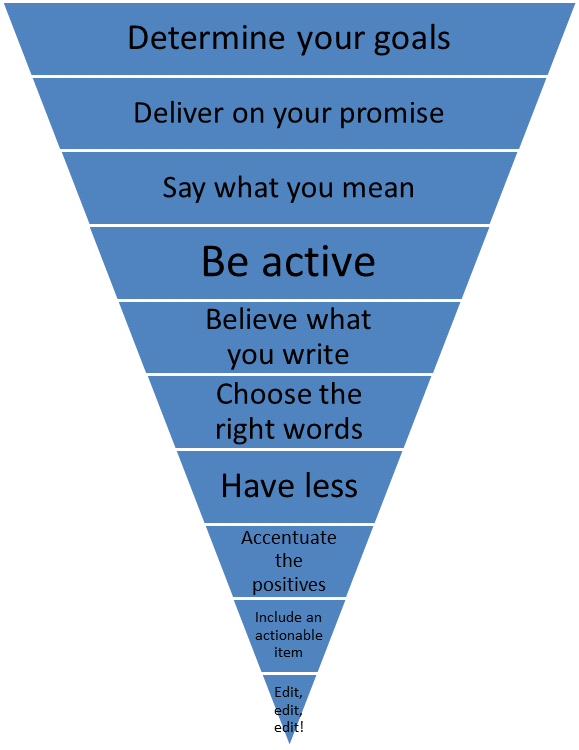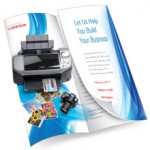10 Building Blocks of Great Copywriting

A copy is about selling an idea, but great copywriting is successfully getting your audience to buy that idea. Although your marketing tools can attract attention for its design and layout, it is the copy that seals the deal with your target market. It can be about getting them to buy your products, become your brand advocate, or sign up on your mailing list.
If you want to bolster your transactions through great copywriting on your marketing tools, below is a diagram of the foundations of writing that sells:
Determine your goals
When writing a great copy, you need to set out your objectives on what you want to achieve with your marketing tool. As mentioned, it can be about making a sale with them or getting leads to be converted into transactions in the future.
One thing to remember here is that the goal needs and will need be your about your audience.
To be able to do this, as well as figure out the tone and kind necessary for great copywriting, write to appease your audience. Put yourself in the shoes of the audience and ask yourself what you can benefit from the product and service being offered. Consider the demographic of your audience to write the appropriate tone necessary to get your message across. Refer to the unique selling proposition of your product as the benefit they will receive from your business.
Delivery on your promise
Your headline and subheadings should engage your audience and set up the expectation for your marketing tools. While you may resort to controversy and emotional appeal to tap the attention of people, make sure that your copy must deliver a concrete idea that reflects the message presented in your marketing tool.
Say what you mean
Great copywriting clarifies ambiguity and ties loose ends together. Getting rid of the clutter in your sentences allows you to express your idea much clearer.
Be active
Using an active voice instead of a passive one strengthens the tone and tightens your copy. An active voice makes for shorter and punchier sentences.
Believe what you write

“Advertising people who ignore research are as dangerous as generals who ignore decodes of enemy signals.” -David Ogilvy
As a writer, you may be forced to talk about a product or service that you don’t feel strongly about. If so, do everything to compelled yourself about the topic. Research and find possible angles related to your interests that you can use as a starting point in learning about the product. At the end of the day, you should write because you have to, but because you want to.
Choose the right words
Among the countless ways of writing down your copy, you have to choose the one that best delivers your idea. This will have to do with your choice of words. Use a dictionary at all times to determine which word should be used.
Have less
The shorter your copy, the faster the message gets through to your audience.
Accentuate the positives
There will be something that your competitors offer much better than your product or service. To avoid running the risk of exposing your shortcomings, magnify your strong points. Focus on pushing your USP to play up the strengths of your product or service that will should cover its negatives.
Include an actionable item
At the end of your marketing tool, compel your audience to perform an action based on the goals you want to achieve. It is important to indicate a single goal instead of multiple things for your audience to do. By keeping your call to action to a minimum, you guide your audience to an unmissable item that they can immediately perform.
Edit, edit, edit
The key to great copywriting is constantly fine-tuning your copy until you come up with the best version possible. Review the copy for grammatical errors and word omissions. Also ensure that your word choices are appropriate and best describe what you want to express.
Learn
Now that you’ve read the fundamentals of great copywriting, it’s time to further expand your knowledge about great copywriting by reading the resources featured below:
Copywriting Tutorials for Crafting Effective Copy – Although applicable mostly for online content marketers, Copyblogger covers a lot of detail about coming up with effective headlines that can be used even by every business owner and copywriter out there.
David Ogilvy’s 7 Tips for Writing Copy That Sells – If you really want to learn great copywriting, then you might as well pick up tips from the best.
Best Copywriting Blogs: The Definitive List of Great Blogs for Marketing Copywriters and Content Developers – There are a lot of copywriting blogs, but Boost CTR handpicks the best among the rest in this roundup post.
Apply
What’s the point of knowing if you are not going to apply them? With PrintRunner, we give you an opportunity to put your newly acquired great copywriting skills to use with our print products.
 We highly recommend our brochure printing for your marketing needs. These are multifolded papers that contain images and information promoting your business.
We highly recommend our brochure printing for your marketing needs. These are multifolded papers that contain images and information promoting your business.




Great post. Lots of really useful tips for copywriting. Thanks for sharing on Bizsugar.com
Thanks. Let me know if you want other topics about copywriting to be covered here on the blog and I'll be more than glad to write about it 😀
Thanks for this posting and tips!
I think one of the most important and key points you make is the last one about edit, edit, edit. Less usually is more when it comes to great copy. Simple, direct and inspired. It is also more likely to be read..
Couldn't agree more. Thanks for reading, Gary!